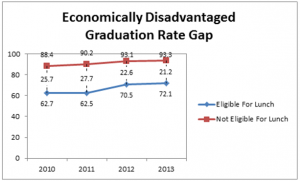Connecticut ranks last for school breakfasts; economics play a role
Posted: May 27, 2014 Filed under: Education, Nutrition Leave a comment » For the last eight years, Connecticut has ranked last in the nation when it comes to number of schools offering breakfast to students. In the last national report in 2012, less than half of students who received free and reduced lunches in Connecticut ate breakfast at school. There’s a clear economic divide between the schools where breakfast is offered and where it isn’t. The state’s larger, lower-income cities generally offer it, and many of the smaller, wealthier communities do not. Here’s Craig LeMoult’s story about school breakfasts in Connecticut:
For the last eight years, Connecticut has ranked last in the nation when it comes to number of schools offering breakfast to students. In the last national report in 2012, less than half of students who received free and reduced lunches in Connecticut ate breakfast at school. There’s a clear economic divide between the schools where breakfast is offered and where it isn’t. The state’s larger, lower-income cities generally offer it, and many of the smaller, wealthier communities do not. Here’s Craig LeMoult’s story about school breakfasts in Connecticut:
Audio Player
This interactive map by the Connecticut State Data Center illustrates the number of school breakfasts served in each school district, compared to the number of students receiving free or reduced-price school breakfast. Towns with more “free & reduced” kids and fewer breakfasts are red.
New Conn. high school graduation rates show continuing economic gap; some progress
Posted: May 14, 2014 Filed under: Education Leave a comment »
The Connecticut Department of Education released new statistics on Wednesday showing an improvement in the percentage of students who graduate in four years, and a slight reduction in the gap based on the economic background of students.
In 2013, 68.6 percent of students who are eligible for a free lunch (the standard way of assessing poverty in schools) graduated in four years. In 2012, that percentage was slightly lower, at about 66 percent. For those who get a reduced-price lunch in 2013, 84.2 percent graduated in four years. Compare that to the percentage for kids whose families make enough money that they don’t qualify for any lunch assistance: 93.3%.
Last year’s numbers were released in August, and were featured here in State of Disparity.
Here’s an interactive map by the Connecticut State Data Center, illustrating graduation rates in each Connecticut school district.
Since 2010, the graduation gap between economically disadvantaged students and their more affluent peers reduced by 4.5 percentage points (17.5 percent).
The DOE has set aside the 30 lowest performing school districts in a designation called “Alliance Districts” that are getting additional funding. Those districts saw a 1.3 percent increase over 2012. Of those, the 10 lowest performing saw a 2.8 percentage-point increase — from 66.3 percent in 2012 to 69.1 percent in 2013.
Four-year graduation rates by district and school are available at the following links: District, School
Of course, if a student doesn’t graduate in four years, it doesn’t necessarily mean they won’t graduate at all (as we saw in this story). So the DOE also released, for the first time, the percentage of students who graduate in five years.
Looking at all students who entered Grade 9 in September 2008 (so they ordinarily would have graduated in 2012) the five-year graduate rate is 87.5 percent – 2.7 percentage points higher than the cohort’s four-year rate. For kids who are
eligible for free or reduced-price lunch, adding that extra year brings up the graduation rate 5.3 percentage points.
Five-year cohort graduation rates by district and school are available at the following links: District, School

This graph from the Conn. Department of Education shows a continuing significant gap in graduation rates between students who qualify for free or reduced-price lunch, and those that don’t. Although the state points out the gap decreased from a 25.7 percentage-point difference in 2010 to a 21.2 percentage-point difference in 2013 for a total reduction of 4.5 points.
There are persistent racial gaps in grad rates, too. In 2013, about 91 percent of white students graduated in four years, while about 76 percent of black students and 70 percent of Hispanic students graduated in the same time.
Listen to Ebong Udoma’s story here:
Audio Player
New Haven starts removing controversial fence between public housing and neighboring Hamden
Posted: May 13, 2014 Filed under: Housing, Income, Politics Leave a comment »
New Haven began demolishing a fence on Monday that for 50 years separated a public housing complex in the city from the town of Hamden. For some, the fence had become a symbol of racial and economic division between two communities. The economic dividing line here is actually not one of the starkest in a state with one of the widest income disparities in the country. The most recent Census figures show median family income on the New Haven side was around $33,000, and it was about $70,000 on the Hamden side. But few places have anything as symbolically and literally divisive as the fence.
Listen to Craig LeMoult’s story here:
Audio Player
A disparity of justice explored in Taibbi’s new book
Posted: May 8, 2014 Filed under: Justice Leave a comment »
 In his new book, “The Divide: American Injustice in the Age of the Wealth Gap,” journalist Matt Taibbi looks at the disparity in how the U.S. justice system treats wealthy people and poor people.
In his new book, “The Divide: American Injustice in the Age of the Wealth Gap,” journalist Matt Taibbi looks at the disparity in how the U.S. justice system treats wealthy people and poor people.
“It’s incredibly easy for people who don’t have money to go to jail for just about anything,” Taibbi told NPR’s Kelly McEvers in April.
“There’s almost an inverse relationship between the ease with which you can put a poor person in jail for, say, welfare fraud, and the difficulty that prosecutors face when they try to put someone from a too-big-to-fail bank in jail for a more serious kind of fraud.”
Here’s Taibbi’s interview with NPR’s Kelly McEvers.
Taibbi uses the example of HSBC, which admitted to washing over $850 million for a pair of Central and South American drug cartels. The bank paid a fine, and no one served a day in jail. He compares that to people who go to jail for having a joint in their pocket.
“I think there’s this weird psychological thing that we’re developing where we just sort of look at one kind of offender and we think that person is appropriate for jail, and another kind of offender we just don’t think that person is appropriate for jail, increasingly,” Taibbi told McEvers.
You can read an excerpt of the book here.
Taibbi was interviewed on the Daily Show in April. Here’s the first part of that interview.
Here’s the second part of Matt Taibbi’s interview on the Daily Show


Recent Comments